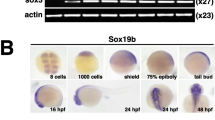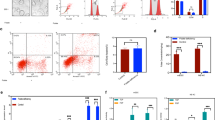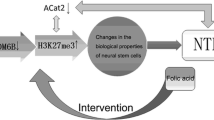Abstract
Primary cilia are crucial for neurogenesis, and cilium-related genes are involved in the closure of neural tubes. Inositol polyphosphate-5-phosphatase (Inpp5e) was enriched in primary cilia and closely related to the occurrence of neural tube defects (NTDs). However, the role of Inpp5e in the development of NTDs is not well-known. To investigate whether Inpp5e gene is associated with the neural tube closure, we established a mouse model of NTDs by 5-fluorouracil (5-FU) exposure at gestational day 7.5 (GD7.5). The Inpp5e knockdown (Inpp5e-/-) mouse embryonic stem cells (mESCs) were produced by CRISPR/Cas9 system. The expressions of Inpp5e and other cilium-related genes including intraflagellar transport 80 (Ift80), McKusick-Kaufman syndrome (Mkks), and Kirsten rat sarcoma viral oncogene homolog (Kras) were determined, utilizing quantitative real-time reverse transcription polymerase chain reaction (qRT-PCR), western blot, PCR array, and immunofluorescence staining. The result showed that the incidence of NTDs was 37.10% (23 NTDs/62 total embryos) and significantly higher than that in the control group (P < 0.001). The neuroepithelial cells of neural tubes were obviously disarranged in NTD embryos. The mRNA and protein levels of Inpp5e, Ift80, Mkks, and Kras were significantly decreased in NTD embryonic brain tissues, compared to the control (P < 0.05). Knockdown of the Inpp5e (Inpp5e-/-) reduced the expressions of Ift80, Mkks, and Kras in mESCs. Furthermore, the levels of α-tubulin were significantly reduced in NTD embryonic neural tissue and Inpp5e-/- mESCs. These results suggested that maternal 5-FU exposure inhibited the expression of Inpp5e, which resulted in the downregulation of cilium-related genes (Ift80, Mkks, and Kras), leading to the impairment of primary cilium development, and ultimately disrupted the neural tube closure.







Similar content being viewed by others
Data Availability
The data that support the findings of this study are available from the corresponding authors upon reasonable request.
References
Facchinetti F, Cavalli P, Copp A et al (2020) An update on the use of inositols in preventing gestational diabetes mellitus (GDM) and neural tube defects (NTDs). Expert Opin Drug Metab Toxicol 16:1187–1198. https://doi.org/10.1080/17425255.2020.1828344
van der Put NM, Gabreëls F, Stevens EM et al A second common mutation in the methylenetetrahydrofolate reductase ge ne: an additional risk factor for neural-tube defects? Am J Hum Genet 62:1044–1051. https://doi.org/10.1086/301825
Copp AJ, Greene NDE Genetics and development of neural tube defects. J Pathol 220:217–230. https://doi.org/10.1002/path.2643
Jacoby M, Cox JJ, Gayral S et al (2009) INPP5E mutations cause primary cilium signaling defects, ciliary instability and ciliopathies in human and mouse. Nat Genet 41:1027–1031. https://doi.org/10.1038/ng.427
Bielas SL, Silhavy JL, Brancati F et al (2009) Mutations in INPP5E, encoding inositol polyphosphate-5-phosphatase E, link phosphatidyl inositol signaling to the ciliopathies. Nat Genet 41:1032–1036. https://doi.org/10.1038/ng.423
Maerz LD, Burkhalter MD, Schilpp C et al (2019) Pharmacological cholesterol depletion disturbs ciliogenesis and ciliary function in developing zebrafish. Commun Biol 2:31. https://doi.org/10.1038/s42003-018-0272-7
Shi H, Wang H, Zhang C et al (2022) Mutations in OSBPL2 cause hearing loss associated with primary cilia defects via sonic hedgehog signaling. JCI Insight 7. https://doi.org/10.1172/jci.insight.149626
Xie C, Habif JC, Ukhanov K et al (2022) Reversal of ciliary mechanisms of disassembly rescues olfactory dysfunction in ciliopathies. JCI Insight 7. https://doi.org/10.1172/jci.insight.158736
Hakim S, Dyson JM, Feeney SJ et al (2016) Inpp5e suppresses polycystic kidney disease via inhibition of PI3K/Akt-dependent mTORC1 signaling. Hum Mol Genet 25:2295–2313. https://doi.org/10.1093/hmg/ddw097
Xu W, Jin M, Huang W et al (2019) Apical PtdIns(4,5)P(2) is required for ciliogenesis and suppression of polycystic kidney disease. Faseb J 33:2848–2857. https://doi.org/10.1096/fj.201800385RRR
Hasenpusch-Theil K, Laclef C, Colligan M et al (2020) A transient role of the ciliary gene Inpp5e in controlling direct versus indirect neurogenesis in cortical development. Elife 9. https://doi.org/10.7554/eLife.58162
Dyson JM, Conduit SE, Feeney SJ et al (2017) INPP5E regulates phosphoinositide-dependent cilia transition zone function. J Cell Biol 216:247–263. https://doi.org/10.1083/jcb.201511055
Barsch F, Niedermair T, Mamilos A et al (2020) Physiological and pathophysiological aspects of primary cilia-a literature review with view on functional and structural relationships in cartilage. Int J Mol Sci 21. https://doi.org/10.3390/ijms21144959
Valente EM, Rosti RO, Gibbs E et al (2014) Primary cilia in neurodevelopmental disorders. Nat Rev Neurol 10:27–36. https://doi.org/10.1038/nrneurol.2013.247
Vogel TW, Carter CS, Abode-Iyamah K et al (2012) The role of primary cilia in the pathophysiology of neural tube defects. Neurosurg Focus 33:E2. https://doi.org/10.3171/2012.6.Focus12222
Shimada IS, Mukhopadhyay S G-protein-coupled receptor signaling and neural tube closure defects. Birth Defects Res 109:129–139. https://doi.org/10.1002/bdra.23567
Boschen KE, Fish EW, Parnell SE Prenatal alcohol exposure disrupts Sonic hedgehog pathway and primary cilia genes in the mouse neural tube. Reprod Toxicol (Elmsford, N.Y.) 105:136–147. https://doi.org/10.1016/j.reprotox.2021.09.002
Yue H, Zhu X, Li S et al (2018) Relationship between INPP5E gene expression and embryonic neural development in a mouse model of neural tube defect. Med Sci Monit 24:2053–2059. https://doi.org/10.12659/msm.906095
Yue H, Li S, Qin J et al (2021) Down-regulation of Inpp5e associated with abnormal ciliogenesis during embryonic neurodevelopment under inositol deficiency. Front Neurol 12:579998. https://doi.org/10.3389/fneur.2021.579998
Wang X, Guan Z, Dong Y et al Inhibition of thymidylate synthase affects neural tube development in mice. Reprod Toxicol (Elmsford, N.Y.) 76:17–25. https://doi.org/10.1016/j.reprotox.2017.12.007
Forcioli-Conti N, Estève D, Bouloumié A et al (2016) The size of the primary cilium and acetylated tubulin are modulated during adipocyte differentiation: analysis of HDAC6 functions in these processes. Biochimie 124:112–123. https://doi.org/10.1016/j.biochi.2015.09.011
Wang X, Wang J, Guan T et al (2014) Role of methotrexate exposure in apoptosis and proliferation during early neurulation. J Appl Toxicol 34:862–869. https://doi.org/10.1002/jat.2901
Zhao J, Guan T, Wang J et al (2013) Influence of the antifolate drug methotrexate on the development of murine neural tube defects and genomic instability. J Appl Toxicol 33:915–923. https://doi.org/10.1002/jat.2769
Ramos AR, Elong Edimo W, Erneux C (2018) Phosphoinositide 5-phosphatase activities control cell motility in glioblastoma: two phosphoinositides PI(4,5)P2 and PI(3,4)P2 are involved. Adv Biol Regul 67:40–48. https://doi.org/10.1016/j.jbior.2017.09.001
Ooms LM, Horan KA, Rahman P et al (2009) The role of the inositol polyphosphate 5-phosphatases in cellular function and human disease. Biochem J 419:29–49. https://doi.org/10.1042/bj20081673
Conduit SE, Davies EM, Fulcher AJ et al (2021) Superresolution microscopy reveals distinct phosphoinositide subdomains within the cilia transition zone. Front Cell Dev Biol 9:634649. https://doi.org/10.3389/fcell.2021.634649
Travaglini L, Brancati F, Silhavy J et al (2013) Phenotypic spectrum and prevalence of INPP5E mutations in Joubert syndrome and related disorders. Eur J Hum Genet 21:1074–1078. https://doi.org/10.1038/ejhg.2012.305
Phua SC, Chiba S, Suzuki M et al (2017) Dynamic remodeling of membrane composition drives cell cycle through primary cilia excision. Cell 168:264–279.e215. https://doi.org/10.1016/j.cell.2016.12.032
Sangermano R, Deitch I, Peter VG et al (2021) Broadening INPP5E phenotypic spectrum: detection of rare variants in syndromic and non-syndromic IRD. NPJ Genom Med 6:53. https://doi.org/10.1038/s41525-021-00214-8
Li S, Luo D, Yue H et al (2021) Neural tube defects: role of lithium carbonate exposure in embryonic neural development in a murine model. Pediatr Res 90:82–92. https://doi.org/10.1038/s41390-020-01244-1
Singla V, Reiter JF (2006) The primary cilium as the cell’s antenna: signaling at a sensory organelle. Science 313:629–633. https://doi.org/10.1126/science.1124534
Guemez-Gamboa A, Coufal NG, Gleeson JG (2014) Primary cilia in the developing and mature brain. Neuron 82:511–521. https://doi.org/10.1016/j.neuron.2014.04.024
Lechtreck KF (2015) IFT-cargo interactions and protein transport in cilia. Trends Biochem Sci 40:765–778. https://doi.org/10.1016/j.tibs.2015.09.003
Taschner M, Weber K, Mourão A et al (2016) Intraflagellar transport proteins 172, 80, 57, 54, 38, and 20 form a stable tubulin-binding IFT-B2 complex. Embo j 35:773–790. https://doi.org/10.15252/embj.201593164
Taschner M, Lorentzen A, Mourão A et al (2018) Crystal structure of intraflagellar transport protein 80 reveals a homo-dimer required for ciliogenesis. Elife 7. https://doi.org/10.7554/eLife.33067
Rix S, Calmont A, Scambler PJ et al (2011) An Ift80 mouse model of short rib polydactyly syndromes shows defects in hedgehog signalling without loss or malformation of cilia. Hum Mol Genet 20:1306–1314. https://doi.org/10.1093/hmg/ddr013
Reck M, Carbone DP, Garassino M et al (2021) Targeting KRAS in non-small-cell lung cancer: recent progress and new approaches. Ann Oncol 32:1101–1110. https://doi.org/10.1016/j.annonc.2021.06.001
Wong SY, Seol AD, So PL et al (2009) Primary cilia can both mediate and suppress Hedgehog pathway-dependent tumorigenesis. Nat Med 15:1055–1061. https://doi.org/10.1038/nm.2011
Youn YH, Hou S, Wu CC et al (2022) Primary cilia control translation and the cell cycle in medulloblastoma. Genes Dev 36:737–751. https://doi.org/10.1101/gad.349596.122
Bangs FK, Miller P, O’Neill E (2020) Ciliogenesis and Hedgehog signalling are suppressed downstream of KRAS during acinar-ductal metaplasia in mouse. Dis Model Mech 13. https://doi.org/10.1242/dmm.044289
Seeley ES, Carrière C, Goetze T et al (2009) Pancreatic cancer and precursor pancreatic intraepithelial neoplasia lesions are devoid of primary cilia. Cancer Res 69:422–430. https://doi.org/10.1158/0008-5472.Can-08-1290
Kobayashi T, Nakazono K, Tokuda M et al (2017) HDAC2 promotes loss of primary cilia in pancreatic ductal adenocarcinoma. EMBO Rep 18:334–343. https://doi.org/10.15252/embr.201541922
Vössing C, Atigbire P, Eilers J et al (2021) The major ciliary isoforms of RPGR build different interaction complexes with INPP5E and RPGRIP1L. Int J Mol Sci 22. https://doi.org/10.3390/ijms22073583
Ukhanov K, Uytingco C, Green W et al (2022) INPP5E controls ciliary localization of phospholipids and the odor response in olfactory sensory neurons. J Cell Sci 135. https://doi.org/10.1242/jcs.258364
Sharif AS, Gerstner CD, Cady MA et al (2021) Deletion of the phosphatase INPP5E in the murine retina impairs photoreceptor axoneme formation and prevents disc morphogenesis. J Biol Chem 296:100529. https://doi.org/10.1016/j.jbc.2021.100529
Acknowledgements
Thanks to Dr. Jing Pan for her constructive suggestions during the process.
Funding
This work was supported by the Natural Science Foundation of Beijing Municipal (7222016), Research Foundation of the Capital Institute of Pediatrics (CXYJ-2021-03, JCYJ-2023-05) and National Natural Science Foundation of China (U23A20420).
Author information
Authors and Affiliations
Contributions
JW, ZG, XW and JY contributed to the study conception and design. XW, JY, and HY performed the experiment and drafted the article. SL, AY, ZZ, and ZG analyzed the data. XW and JW made contribution to the funding acquisition. All authors approved the final manuscript.
Corresponding authors
Ethics declarations
Ethics Approval
All animal experiments were reviewed and approved by the Ethics Committee of the Capital Institute Pediatrics (DWLL2021013). All procedures are strictly in compliance with the relevant regulations of the Chinese Council on Animal Care.
Consent to Participate
None.
Consent for Publication
None.
Competing Interests
The authors declare no competing interests.
Additional information
Publisher’s Note
Springer Nature remains neutral with regard to jurisdictional claims in published maps and institutional affiliations.
Supplementary Information
ESM 1
(DOC 12.5 mb)
Rights and permissions
Springer Nature or its licensor (e.g. a society or other partner) holds exclusive rights to this article under a publishing agreement with the author(s) or other rightsholder(s); author self-archiving of the accepted manuscript version of this article is solely governed by the terms of such publishing agreement and applicable law.
About this article
Cite this article
Wang, X., Yu, J., Yue, H. et al. Inpp5e Regulated the Cilium-Related Genes Contributing to the Neural Tube Defects Under 5-Fluorouracil Exposure. Mol Neurobiol (2024). https://doi.org/10.1007/s12035-024-03946-7
Received:
Accepted:
Published:
DOI: https://doi.org/10.1007/s12035-024-03946-7




